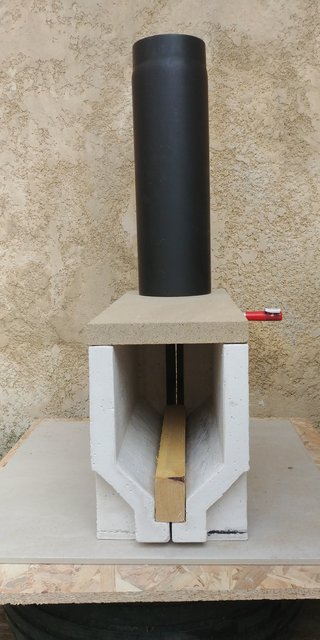Post by nixsee on Dec 24, 2020 12:02:27 GMT -8
I've been tinkering with various basic L Tube cookstoves and they work well enough, but sometimes they can get randomly sooty and I also have some applications that need a higher powered output within a small form-factor. I just discovered the Batch Box stove which seems to be, in essence, a large and more efficient L-tube stove. I'm wondering if its concepts could be applied successfully in this smaller format and different application? Namely:
1. A port in front of the riser to encourage additional mixing, whereas the L-tube Rocket Stove gospels tend to advocate for uniform CSA throughout to ensure smooth flow of air (the opposite of turbulence)
2. Moreover, with wood taking up much of the CSA, it could be argued that a larger Batch Box-style fuel section is necessary to actually to allow for the riser's airflow and mixing capacity to be fully utilized, while also having more wood burning at one time.
3. A P-Channel: to keep it simple, just a thin channel running along the inside of the fuel section's ceiling and opening up in front of the port
I'm not sure that it would work as well with the standard aprovecho-style 5 gallon bucket 4" diameter, 12" riser L-tube cookstove given the limited horizontal space to work with - losing 4" from the riser is about half the length (or maybe it doesn't matter if the wood sticks far out the front? Not sure how the horizontal length affects performance). But I'm also currently experimenting with one in a half-drum - 22" diameter and 19" height. The horizontal section is about 14", as is the riser.
Does this make any sense? The riser won't be nearly as tall as in Peterburg's specs and the batch box will surely be smaller, but it seems like these features should be able to make small stoves far more efficient and powerful.
A final question: would a typical fuel-shelf be necessary with this? It seems like batch boxes and even J tube stoves don't even have one - air enters through the wood and P Channels are often above instead of below - the port would ensure that everything gets mixed together violently, burning the coals efficiently.
Thanks!
1. A port in front of the riser to encourage additional mixing, whereas the L-tube Rocket Stove gospels tend to advocate for uniform CSA throughout to ensure smooth flow of air (the opposite of turbulence)
2. Moreover, with wood taking up much of the CSA, it could be argued that a larger Batch Box-style fuel section is necessary to actually to allow for the riser's airflow and mixing capacity to be fully utilized, while also having more wood burning at one time.
3. A P-Channel: to keep it simple, just a thin channel running along the inside of the fuel section's ceiling and opening up in front of the port
I'm not sure that it would work as well with the standard aprovecho-style 5 gallon bucket 4" diameter, 12" riser L-tube cookstove given the limited horizontal space to work with - losing 4" from the riser is about half the length (or maybe it doesn't matter if the wood sticks far out the front? Not sure how the horizontal length affects performance). But I'm also currently experimenting with one in a half-drum - 22" diameter and 19" height. The horizontal section is about 14", as is the riser.
Does this make any sense? The riser won't be nearly as tall as in Peterburg's specs and the batch box will surely be smaller, but it seems like these features should be able to make small stoves far more efficient and powerful.
A final question: would a typical fuel-shelf be necessary with this? It seems like batch boxes and even J tube stoves don't even have one - air enters through the wood and P Channels are often above instead of below - the port would ensure that everything gets mixed together violently, burning the coals efficiently.
Thanks!

